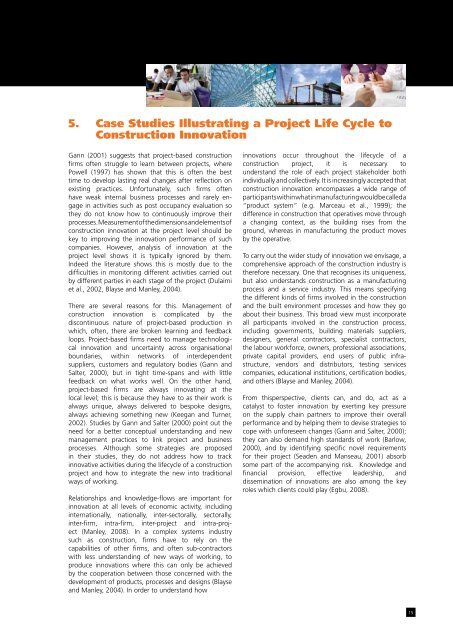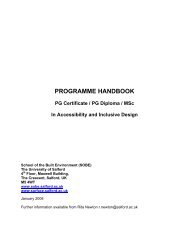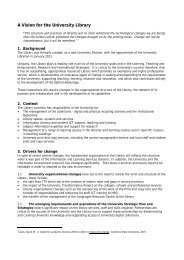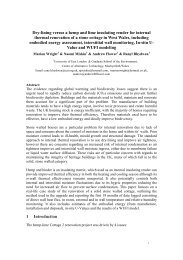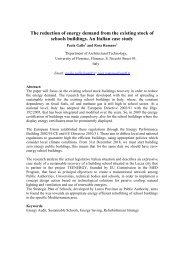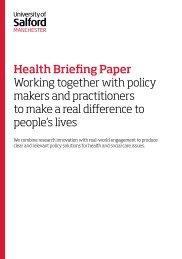Innovation in Construction A Project Life Cycle Approach
Innovation in Construction A Project Life Cycle Approach
Innovation in Construction A Project Life Cycle Approach
You also want an ePaper? Increase the reach of your titles
YUMPU automatically turns print PDFs into web optimized ePapers that Google loves.
5. Case Studies Illustrat<strong>in</strong>g a <strong>Project</strong> <strong>Life</strong> <strong>Cycle</strong> to<strong>Construction</strong> <strong>Innovation</strong>Gann (2001) suggests that project-based constructionfirms often struggle to learn between projects, wherePowell (1997) has shown that this is often the besttime to develop last<strong>in</strong>g real changes after reflection onexist<strong>in</strong>g practices. Unfortunately, such firms oftenhave weak <strong>in</strong>ternal bus<strong>in</strong>ess processes and rarely engage<strong>in</strong> activities such as post occupancy evaluation sothey do not know how to cont<strong>in</strong>uously improve theirprocesses. Measurement of the dimensions and elements ofconstruction <strong>in</strong>novation at the project level should bekey to improv<strong>in</strong>g the <strong>in</strong>novation performance of suchcompanies. However, analysis of <strong>in</strong>novation at theproject level shows it is typically ignored by them.Indeed the literature shows this is mostly due to thedifficulties <strong>in</strong> monitor<strong>in</strong>g different activities carried outby different parties <strong>in</strong> each stage of the project (Dulaimiet al., 2002, Blayse and Manley, 2004).There are several reasons for this. Management ofconstruction <strong>in</strong>novation is complicated by thediscont<strong>in</strong>uous nature of project-based production <strong>in</strong>which, often, there are broken learn<strong>in</strong>g and feedbackloops. <strong>Project</strong>-based firms need to manage technological<strong>in</strong>novation and uncerta<strong>in</strong>ty across organisationalboundaries, with<strong>in</strong> networks of <strong>in</strong>terdependentsuppliers, customers and regulatory bodies (Gann andSalter, 2000), but <strong>in</strong> tight time-spans and with littlefeedback on what works well. On the other hand,project-based firms are always <strong>in</strong>novat<strong>in</strong>g at thelocal level; this is because they have to as their work isalways unique, always delivered to bespoke designs,always achiev<strong>in</strong>g someth<strong>in</strong>g new (Keegan and Turner,2002). Studies by Gann and Salter (2000) po<strong>in</strong>t out theneed for a better conceptual understand<strong>in</strong>g and newmanagement practices to l<strong>in</strong>k project and bus<strong>in</strong>essprocesses. Although some strategies are proposed<strong>in</strong> their studies, they do not address how to track<strong>in</strong>novative activities dur<strong>in</strong>g the lifecycle of a constructionproject and how to <strong>in</strong>tegrate the new <strong>in</strong>to traditionalways of work<strong>in</strong>g.Relationships and knowledge-flows are important for<strong>in</strong>novation at all levels of economic activity, <strong>in</strong>clud<strong>in</strong>g<strong>in</strong>ternationally, nationally, <strong>in</strong>ter-sectorally, sectorally,<strong>in</strong>ter-firm, <strong>in</strong>tra-firm, <strong>in</strong>ter-project and <strong>in</strong>tra-project(Manley, 2008). In a complex systems <strong>in</strong>dustrysuch as construction, firms have to rely on thecapabilities of other firms, and often sub-contractorswith less understand<strong>in</strong>g of new ways of work<strong>in</strong>g, toproduce <strong>in</strong>novations where this can only be achievedby the cooperation between those concerned with thedevelopment of products, processes and designs (Blayseand Manley, 2004). In order to understand how<strong>in</strong>novations occur throughout the lifecycle of aconstruction project, it is necessary tounderstand the role of each project stakeholder both<strong>in</strong>dividually and collectively. It is <strong>in</strong>creas<strong>in</strong>gly accepted thatconstruction <strong>in</strong>novation encompasses a wide range ofparticipants with<strong>in</strong> what <strong>in</strong> manufactur<strong>in</strong>g would be called a“product system” (e.g. Marceau et al., 1999); thedifference <strong>in</strong> construction that operatives move througha chang<strong>in</strong>g context, as the build<strong>in</strong>g rises from theground, whereas <strong>in</strong> manufactur<strong>in</strong>g the product movesby the operative.To carry out the wider study of <strong>in</strong>novation we envisage, acomprehensive approach of the construction <strong>in</strong>dustry istherefore necessary. One that recognises its uniqueness,but also understands construction as a manufactur<strong>in</strong>gprocess and a service <strong>in</strong>dustry. This means specify<strong>in</strong>gthe different k<strong>in</strong>ds of firms <strong>in</strong>volved <strong>in</strong> the constructionand the built environment processes and how they goabout their bus<strong>in</strong>ess. This broad view must <strong>in</strong>corporateall participants <strong>in</strong>volved <strong>in</strong> the construction process,<strong>in</strong>clud<strong>in</strong>g governments, build<strong>in</strong>g materials suppliers,designers, general contractors, specialist contractors,the labour workforce, owners, professional associations,private capital providers, end users of public <strong>in</strong>frastructure,vendors and distributors, test<strong>in</strong>g servicescompanies, educational <strong>in</strong>stitutions, certification bodies,and others (Blayse and Manley, 2004).From thisperspective, clients can, and do, act as acatalyst to foster <strong>in</strong>novation by exert<strong>in</strong>g key pressureon the supply cha<strong>in</strong> partners to improve their overallperformance and by help<strong>in</strong>g them to devise strategies tocope with unforeseen changes (Gann and Salter, 2000);they can also demand high standards of work (Barlow,2000), and by identify<strong>in</strong>g specific novel requirementsfor their project (Seaden and Manseau, 2001) absorbsome part of the accompany<strong>in</strong>g risk. Knowledge andf<strong>in</strong>ancial provision, effective leadership, anddissem<strong>in</strong>ation of <strong>in</strong>novations are also among the keyroles which clients could play (Egbu, 2008).15


